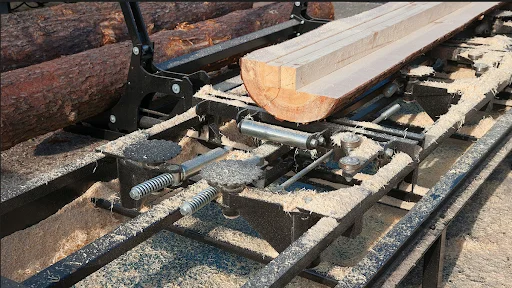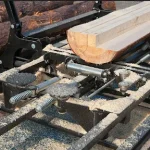With over 130 million hectares of forested land and close to 2 million hectares reserved for commercial plantations, Australia is a global leader in the timber industry. Wood is an essential raw material spanning multiple industries, from construction and furniture manufacturing to paper and packaging. The industry directly employs over 50 thousand workers and contributes roughly $50 billion in overall sales and services to the local economy of Wood Processing.
Before finished products such as tables, doors, timber columns, plywood, and flooring hit the shelves, trees undergo primary and secondary processing with a range of woodworking machines. Primary processing converts logs into raw wood products, such as beams, rafters and planks. This encompasses multiple fabrication processes, from debarking, sorting and sawing to chipping and veneer production, then drying wood to reduce moisture content.
Finished products can be used as is, or undergo secondary processing, which aims to transform timber into value-added products, such as furniture, flooring and cladding. Here, machining wood involves common techniques, ranging from planing, sanding, turning and cutting, as well as treating and finishing. Each process involves the use of different woodworking machinery.
Key Processes and Machinery in Primary Wood Processing

Sawmilling is the first essential stage that transforms logs and bolts into sawn lumber. This conversion process takes place in sawmills – facilities equipped with machinery that transforms raw logs into ready wood products used in multiple industries. Logs first undergo debarking, or removing the outer bark, by being fed into large rotating cylinders called drum debarkers, ideal for processing high volumes of logs of varying size and species, or placed on roller debarkers capable of stripping bark off challenging tree species.
Logs then move onto sawing. Raw logs are cut into planks and boards using either circular or horizontal and vertical band saws. These produce squared-off timbers in larger diameters, which are also the mainstay of the timber industry, with the highest value. Alternatively, veneers are produced by slicing or peeling logs, often with gang rip saws, producing multiple narrow strips in one pass. Lower quality logs undergo chipping and are placed in disc chippers with rotary cutting blades with high processing capacities, or drum chippers with rotating cutting drums that create wood chips as logs are spun inside.
Where the industry has evolved is with trailer-top portable sawmills that allow for easier access to lumber sites, as well as simplified transportation and control systems embodied in conveyors and CNC automation. These have increased processing efficiency and precision and lessened the burden of labour-intensive tasks. Processed wood moves to kilns with controlled temperatures, humidity levels and airflow, where it’s dried to a target moisture content (often between 6 and 12%). This prevents warping, twisting and cracking and increases overall strength and durability. Dried wood is then sorted by quality, size and species and is ready for secondary processing.
Unlock new perspectives — explore this related post for eye-opening insights.
Value-Added Wood Products Derived From Secondary Processing

Secondary processing involves transforming primary-cut wood by applying a series of mechanical, chemical and finishing processes. After drying, logs are machined and shaped to the specified dimensions and surface finishes required in finished goods. This encompasses common techniques such as sawing, planing, sanding and trimming.
Cut wood is then treated with chemicals and coatings to prevent decay, water ingress and UV damage and improve the material’s durability, colour and exterior finish. Separate pieces can then be assembled into finished products, such as door frames or furniture pieces, during assembly and joining. And lower quality chip and wood pulp can be further processed to produce mulch for landscaping, paper, packaging and specialised products ranging from food agents and binding additives to cellulose for the textile industry.
Common woodworking machines used in secondary processing include:
Cutting and Shaping Machinery
Saws
This includes circular saws for crosscuts (perpendicular to the grain) and rips (along the grain) from toothed abrasive discs or blades to produce high-precision cuts in the desired depths; bandsaws with long narrow blades set in a continuous loop for intricate curved cuts, re-sawing thicker timber pieces and achieving smooth edges; table saws as larger and more stable stationary machines with a protruding circular saw ideal for precision crosscuts and rips in hardwoods; and mitre saws for angled and bevelled cuts for parts like moulding and framing pieces.
Other saw types include tabletop scroll saws for intricate cuts from their thinner, suspended blades; panel saws, either in a horizontal or vertical setup for clean, accurate cuts from a moving blade and larger beam saws when shaping large panels of particleboard, plywood and MDF, often with the help of advanced CNC automation.
Routers
These are used for hollowing tasks, trimming edges and shaping wood surfaces, ideal for carving, profiling and creating slots, grooves and dados with high precision and to the desired depths.
Planer Jointers/Thicknessers
Planers, jointers or thicknessers are used to shave boards down to specified thicknesses. This is ideal for smoothing and flattening rough pieces of primary-cut boards. Jointers additionally flatten the face of boards and create straight edges, necessary for jointing, thus the name.
Lathes
Wood lathes rotate wood workpieces on a central axis, creating everyday cylindrical products like furniture legs, wooden cutlery and intricate pieces such as musical instruments. With a range of tooling such as gouges and chisels, lathes can also be used for sanding, drilling and facing wood.

Belt linishers and sanders have two drums with looped sandpaper in the form of a continuous belt, used to level or flatten uneven boards and panels. They’re also common in heavy-duty sanding and finishing tasks, creating smooth surfaces in doors or structural beams, as well as shaping round edges and removing blemishes in plywood and MDF sheets.
These same sheets are processed with edgebanders – machines that add ‘edge bands’ to exposed edges, then trim excess materials and add adhesives to create a seamless wood veneer look and improve workpiece durability.
Further machining, processing and finishing is achieved with geared and pedestal drills when drilling holes for fasteners. And hot presses for bonding and laminating wood veneers into boards and plywood used for various furniture pieces, doors, partition walls and more.
Buying Considerations
Select machines based on the required fabricating and finishing processes (lathes, CNC routers and thicknessers offer higher versatility); project demands in terms of scope and type, with machines of varied sizes, power sources and features; the level of required precision and ease of use (CNC machines rule here, but come at a premium), build quality and materials for lasting durability and repeatable results; and of course woodworking machinery that suits your budget without creating restraints on growing your business.
Go further — explore more paths that turn curiosity into actionable knowledge.







